Read Time: 6 Minutes Subscribe & Share
 Your Summer Assignment
Your Summer Assignment
Perhaps this annual rite in Kitchen Detail is a hangover from my high school and college days, when I always had a summer reading list. The books chosen, clearly by teachers and professors who had no sympathy with my summer plans, were always serious and had too many pages. Nothing fun or even slightly humorous. No surprise the lure of Cliff Notes. But even so, some of the biographies I resentfully read have remained glued in my brain. And I now enjoy reading autobiographies even more. (Even Proust’s In Search Of Lost Time is interesting to revisit – but only one or two chapters at at a time). A biography is always going to be someone else’s view of who you are. Your story will have an analysis from someone else (who may or may not have a personal agenda coloring the way you are portrayed.)
An autobiography, on the other hand, is a study of how you hold the mirror up to yourself, which angle you are going to reflect on whom you have become, what part of your history you remember and want to share that may not have been public. Some personal storytellers see themselves only from a complimentary three-quarter view in the looking glass; others give the reader a full frontal version. And of course, some writers are better at retelling their lives than others, or they have editors who take them in hand. Here are three very different food-related autobiographies that make good reading when you need to stay out of the heat.
As a side note, I always order my books through Old Town Books which offers exemplary service for pick up, plus loyalty discounts and delivery. As we all well know, Amazon is your reading frenemy.
Finding Freedom
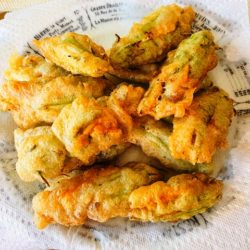 Finding Freedom, is a book by Erin French, the newest author on the KD reading list. She wrote a cookbook that I ended up purchasing after reading her story. I have cooked out of it happily for at least two months – her technique for making fried zucchini blossoms is spot on. She writes a stark tale of her adolescence working in her father’s diner, painfully becoming
Finding Freedom, is a book by Erin French, the newest author on the KD reading list. She wrote a cookbook that I ended up purchasing after reading her story. I have cooked out of it happily for at least two months – her technique for making fried zucchini blossoms is spot on. She writes a stark tale of her adolescence working in her father’s diner, painfully becoming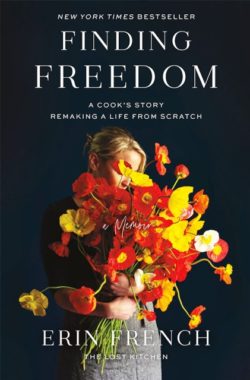 a cook-owner (she does not like to call herself a chef) of a restaurant. Her path forward to reclaiming the deserted mill in her hometown, which she basically never left except for a brief tenure at a college in Boston, is jaw-dropping Her writing style was a little jarring for me, but I got into the choppy rhythm of it once I figured that her editor guided her between the more polished style of an adult writer and one of post-adolescent anger.
a cook-owner (she does not like to call herself a chef) of a restaurant. Her path forward to reclaiming the deserted mill in her hometown, which she basically never left except for a brief tenure at a college in Boston, is jaw-dropping Her writing style was a little jarring for me, but I got into the choppy rhythm of it once I figured that her editor guided her between the more polished style of an adult writer and one of post-adolescent anger.
One could suppose that while she and her stalwart and steady mother were not physically abused, they certainly were emotionally wounded by Erin’s father. Clearly a lot of verbal torment and rejection. In fact, I found her mother’s continued, and in many instances silent, support of her daughter through her brutal journey from childhood, pregnancy and motherhood, domestic abuse and addiction to be as compelling as Erin’s own story. And in the end, it is not only Erin who finds freedom in a place she never left, but also her mother — in the most surprising metier.
The Lost Ravioli Recipes Of Hoboken
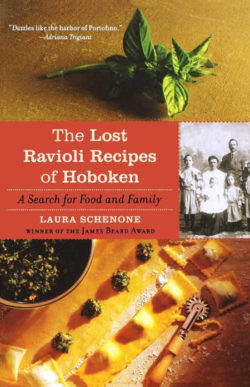 One of the surprising discoveries about Laura Schenone is that she first wrote a prize-winnng book titled A Thousand Years Over A Hot Stove – A History of American Women Told Through Food Recipes And Remembrances. Then she wrote this memoir following her quest to replicate her great grandmother’s recipe for ravioli, unearthing her Italian heritage along the way. She followed that with TheDogs Of Avalon – A Race To Save Animals In Peril,
One of the surprising discoveries about Laura Schenone is that she first wrote a prize-winnng book titled A Thousand Years Over A Hot Stove – A History of American Women Told Through Food Recipes And Remembrances. Then she wrote this memoir following her quest to replicate her great grandmother’s recipe for ravioli, unearthing her Italian heritage along the way. She followed that with TheDogs Of Avalon – A Race To Save Animals In Peril,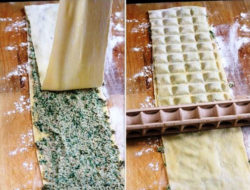 apparently an engrossing but somewhat circuitous saga of the history and plight of racing greyhounds. Clearly a writer who does not sit still in one field. If Proust pushes you down a rabbit hole of memory with a madeleine, Schenone unravels the history and family stories surrounding a hand-carved ravioli press — perhaps brought over by Adalgiza Schenone from Liguria to New Jersey or made for her in her new home in Hoboken.
apparently an engrossing but somewhat circuitous saga of the history and plight of racing greyhounds. Clearly a writer who does not sit still in one field. If Proust pushes you down a rabbit hole of memory with a madeleine, Schenone unravels the history and family stories surrounding a hand-carved ravioli press — perhaps brought over by Adalgiza Schenone from Liguria to New Jersey or made for her in her new home in Hoboken.
She also dissects the internecine quarrels of her family (they never forgive each other but do get together for Christmas). I enjoyed the complicated and sometimes disorderly prose. There are some grainy photos dispersed throughout the book and also an extensive section at the end where she shares her hard-won recipes, techniques and tools. To see the talisman ravioli press and watch the author create her ravioli, watch this charming video. I was surprised by the method of spreading the filling across the sheet of pasta as if it were a savory frosting, then slapping on the top layer of pasta, and running a wood ravioli pin over it. Genius!
The Apprentice
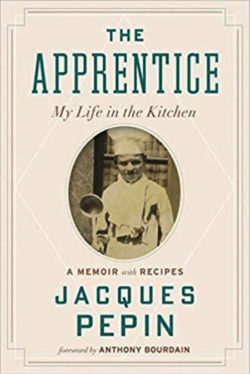 Of the three writers, for my reading, Jacques Pepin (The Apprentice) is the smoothest storyteller. Consider that he left home at the age of thirteen to work as an apprentice in a rural hotel in France ; made his way from some prestigious restaurants in Paris to New York to work long hours in a premier French restaurant with the famously abusive Henri Soulé; and then flourished in a most surprising and rewarding stint with the founder of the Howard Johnson chain of restaurants.
Of the three writers, for my reading, Jacques Pepin (The Apprentice) is the smoothest storyteller. Consider that he left home at the age of thirteen to work as an apprentice in a rural hotel in France ; made his way from some prestigious restaurants in Paris to New York to work long hours in a premier French restaurant with the famously abusive Henri Soulé; and then flourished in a most surprising and rewarding stint with the founder of the Howard Johnson chain of restaurants.
Since he had been deprived of a secondary school education, Jacques Pepin first enrolled in the GED program offered to foreign students by Columbia University. While working full time, he achieved that goal and then earned his Bachelor of Arts degree followed by a Masters degree in French Literature. He loved his scholarly studies and entered into a Ph.D. program at Columbia with the goal of becoming a professor and leaving the exhausting life of professional restaurant kitchens. Midway through his doctoral program, his thesis of the history of French food presented in context of French literature was rejected by his advisor (a French man) who said “cuisine is not a serious art form. It’s far too trivial for academic study. Not intellectual enough to form the basis of a Ph.D. thesis.”
academic study. Not intellectual enough to form the basis of a Ph.D. thesis.”
Pepin’s stories, from the one about being left alone to herd sheep at the age of six to his hilarious escapade in foraging for snails in upstate New York, always end with one of his recipes. I am looking forward to recreating his braised rabbit in cooler weather. Pepin, currently in his mid 80s, still works with his foundation, which trains formerly incarcerated men and women in professional cooking skills. And if that is not enough to occupy him, he also has a most entertaining website (with online shopping) for his artwork.

Kitchen Detail shares under the radar recipes, explores the art of cooking, the stories behind food, and the tools that bring it all together, while uncovering the social, political, and environmental truths that shape our culinary world.




I have been reading In Search of Lost Time in spurts since college. I was mortified to learn recently that the late author Shelby Foote had read it nine times. Jacques Pepin is a treasure and a totally kind and generous fellow. I asked him about his last meal, expecting something grand and glorious. His response was his mother’s freshly baked bread out of the oven and peach preserves made from the trees behind their house. And he added “and of course French butter.” Food is about pleasure and memory.
Hello Gerald,
Well it makes sense that Shelby Foote read it several times. He also wrote all of his novels in a nib pen, to quote Wikipedia.
I enjoy Jacques Pepin’s current videos too.
Nancy